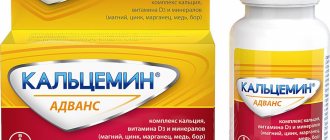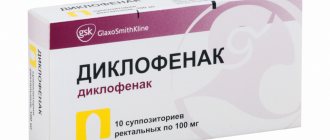pharmachologic effect
Stimulates cartilage restoration and reduces inflammation.
- Chondroitin sulfate is a substance involved in the formation of healthy cartilage tissue. At the same time, the viscosity of the synovial fluid is maintained, and enzymes that destroy cartilage are inhibited. In osteoarthritis, it reduces the manifestations of the disease and helps reduce the dose of non-steroidal anti-inflammatory drugs.
- Glucosamine sulfate improves the synthesis of substances that are the main components of cartilage, joint membranes and synovial fluid.
- Ibuprofen provides an anti-inflammatory effect, reduces pain, and has an antipyretic effect due to the blockade of cyclooxygenase-1 and cyclooxygenase-2 .
Glucosamine and chondroitin increase the analgesic effect of ibuprofen .
Pharmacodynamics and pharmacokinetics
The bioavailability of glucosamine is about 25%, with the highest concentration of the substance found in joint cartilage, liver and kidneys, the highest concentration found in liver, kidneys and joint cartilage. Almost 30% of the incoming substance remains in the muscles and bones for quite a long time. The half-life is about 3 days, excreted in the urine.
The bioavailability of chondroitin sulfate after absorption from the gastrointestinal tract is approximately 13%. The maximum concentration occurs after 4 hours in the blood, and in the intra-articular fluid - within 5 hours. A large amount is found in synovial fluid. It is excreted from the body in urine.
After oral administration of ibuprofen, its maximum concentration occurs within 1 hour. Capable of binding to plasma proteins by 99% and penetrating into the intra-articular fluid. Metabolized in the liver, excreted by the kidneys. The half-life is about 3 hours.
Pharmacological properties of the drug Teraflex Advance
Chondroitin sulfate is a high molecular weight mucopolysaccharide that takes part in the construction of cartilage tissue. Reduces the activity of enzymes that destroy articular cartilage and stimulates the regeneration of the latter. In the early stages of the inflammatory process, chondroitin sulfate reduces its activity and thus slows down the degeneration of cartilage tissue. Eliminates pain, improves joint function, reduces the need for NSAIDs in patients with osteoarthritis of the knee and hip joints. Glucosamine sulfate has chondroprotective properties, reduces the deficiency of glycosamines in the body, and takes part in the biosynthesis of proteoglycans and hyaluronic acid. Having an affinity for cartilage tissue, glucosamine initiates the process of sulfur fixation during the synthesis of chondroitinsulfuric acid. Glucosamine sulfate selectively acts on articular cartilage, is a specific substrate and stimulator of the synthesis of hyaluronic acid and proteoglycans, inhibits the formation of superoxide radicals and enzymes that cause damage to cartilage tissue (collagenase and phospholipase); prevents disruption of glycosaminoglycan biosynthesis induced by NSAIDs and the destructive effect of glucocorticoids on chondrocytes. Ibuprofen has analgesic, anti-inflammatory, and antipyretic effects. The mechanism of action of ibuprofen occurs due to the selective blocking of cyclooxygenase (COX-1 and -2), the main enzyme in the metabolism of arachidonic acid, which leads to a decrease in the synthesis of prostaglandins. Reduces morning stiffness of joints, helps increase range of motion in joints and spine. Pharmacokinetics. Absorption: after a single oral dose of the drug in an average therapeutic dose, the maximum concentration of chondroitin sulfate in the blood plasma is achieved after 3-4 hours, in the synovial fluid - after 4-5 hours. Bioavailability of the drug is 13%. Excretion is carried out mainly by the kidneys within 24 hours. 90% of glucosamine taken enterally is absorbed in the intestine. Over 25% of the dose taken penetrates from the blood plasma into the cartilage tissue and synovial membranes of the joints. In the liver, part of the drug is metabolized to form urea, carbon dioxide and water. The bioavailability of glucosamine is 25% due to primary passage through the liver. The maximum concentration of glucosamine is determined in articular cartilage, liver and kidneys. About 30% of the dose taken persists for a long time in bone and muscle tissue. It is excreted primarily in urine unchanged, and partially in feces. The half-life is 68 hours. Ibuprofen, when administered orally, is almost completely absorbed from the gastrointestinal tract. Eating food at the same time slows down the rate of absorption. Metabolized in the liver (up to 90%). The half-life is 2–3 hours; 80% of the dose taken is excreted in the urine, mainly in the form of metabolites.
Contraindications
- ulcerative lesions of the gastrointestinal tract ( gastric ulcer , Crohn's disease , ulcerative colitis);
- gastrointestinal bleeding;
- intracranial hemorrhages;
- bleeding disorders;
- aspirin asthma;
- hemorrhagic diathesis;
- children under 12 years of age;
- individual intolerance to the constituent components of the drug;
- pregnancy and breastfeeding;
- hypersensitivity to aspirin and NSAIDs.
Prescribed cautiously for arterial hypertension, heart failure, severe damage to kidney and liver function, gastrointestinal diseases, hyperbilirubinemia, nephrotic syndrome, blood diseases, diabetes mellitus , bronchial asthma , and in elderly patients.
In case of intolerance to seafood products, the likelihood of developing an allergy to the drug increases.
Side effects
Nausea, diarrhea , abdominal pain, flatulence, constipation and allergic reactions may occur. If the drug is discontinued, the side effects disappear.
Most adverse reactions occur to ibuprofen , which is part of the drug.
- Digestive system: dry mouth, stomatitis, abdominal pain, heartburn, nausea and vomiting, flatulence, constipation and diarrhea, pancreatitis and hepatitis.
- Respiratory system: bronchospasm and shortness of breath.
- CNS: dizziness, headache, irritability, insomnia, drowsiness, depression, hallucinations and confusion.
- Sense organs: hearing changes (noise or ringing in the ears, hearing loss), dry eyes, double vision, swelling of the eyelids and conjunctiva.
- Heart and blood vessels: rapid heartbeat, increased blood pressure, heart failure.
- Urinary system: nephrotic syndrome , cystitis , nephritis , acute renal failure.
- Hematopoietic system: thrombocytopenia , anemia , leukopenia , thrombocytopenic purpura, increased duration of bleeding.
- Allergic reactions: erythematous rash , skin itching, urticaria, anaphylactic shock , Quincke's edema , bronchospasm, exudative erythema multiforme, Lyell's syndrome, allergic rhinitis, eosinophilia.
Instructions for use TERAFLEX ADVANCE
Determination of the frequency of adverse reactions:
- very often (≥1/10), often (≥1/100-<1/10), infrequently (≥1/1000-<1/100), rarely (≥1/10,000-<1/1000), very rare (<1/10,000), unknown (cannot be determined based on available data).
Glucosamine sulfate
From the digestive system:
often - discomfort and abdominal pain, dyspepsia, constipation, nausea, flatulence, diarrhea.
For the skin and subcutaneous tissues:
uncommon - itching, erythema, skin rash;
- unknown - hair loss.
- unknown - dizziness.
- sometimes - gastric/duodenal ulcers with the likelihood of bleeding and perforation, ulcerative stomatitis, exacerbation of ulcerative colitis or Crohn's disease, gastritis;
- very rarely - esophagitis, pancreatitis, formation of diaphragm-like intestinal strictures. If you experience severe pain in the upper abdomen, tarry stools, or bloody vomiting, you should immediately stop taking Theraflex Advance and consult a doctor.
- nephrotic syndrome;
- interstitial nephritis, which may be accompanied by acute renal failure. In rare cases, damage to the kidney tissue (necrosis of the renal papillae) with an increase in the concentration of uric acid in the blood. Therefore, regular monitoring of kidney function is necessary.
From the immune system:
uncommon - allergic reactions, bronchial asthma.
From the nervous system:
often - headache, drowsiness, fatigue;
From the side of the organ of vision:
infrequently - visual impairment.
From the side of metabolism:
infrequently - increased blood glucose levels.
Chondroitin sulfate
From the skin and subcutaneous tissue:
There are reports of isolated cases of erythema, urticaria, dermatitis, maculopapular rash with or without itching and/or swelling.
From the digestive system:
rarely - cases of nausea, vomiting.
Ibuprofen
The following adverse reactions were observed during treatment with ibuprofen, incl. during long-term treatment with high doses in patients suffering from rheumatism. The established frequency, including very rare cases, refers to short-term treatment in daily doses of up to 1200 mg ibuprofen for the oral dosage form and up to 1800 mg for suppositories.
The following adverse drug reactions mainly vary depending on the dose and individual patient characteristics.
The most common reactions are from the digestive system. Thus, it is possible to develop a peptic ulcer, perforation or gastrointestinal bleeding, sometimes fatal, especially in elderly patients. There is information about the appearance of nausea, vomiting, diarrhea, flatulence, constipation, dyspepsia, abdominal pain, tarry stools, ulcerative stomatitis, as well as exacerbation of ulcerative colitis and Crohn's disease after taking ibuprofen. Gastritis has been reported less frequently. The risk of gastrointestinal bleeding depends on the dose and duration of ibuprofen use.
The development of edema, increased blood pressure and the development of heart failure have been reported during treatment with NSAIDs.
Based on clinical trial and epidemiological data, the use of ibuprofen, especially in high doses (2400 mg per day / 24 capsules) and during long-term therapy, may be associated with a slight increase in the risk of developing conditions caused by arterial thrombosis (for example, myocardial infarction or stroke).
From the cardiovascular system:
very rarely - rapid heartbeat, heart failure, myocardial infarction.
From the hematopoietic system:
very rarely - hematopoietic disorders (anemia, leukopenia, thrombocytopenia, pancytopenia, agranulocytosis). The first signs are fever, sore throat, superficial wounds in the mouth, flu-like symptoms, severe weakness, nosebleeds and hemorrhages in the skin. During long-term treatment with the drug, a complete blood count should be performed regularly.
From the nervous system:
sometimes - central nervous system disorders such as headache, dizziness, insomnia, agitation, irritability or fatigue.
From the side of the organ of vision:
sometimes - visual impairment.
From the organ of hearing and labyrinth:
rarely - tinnitus.
From the digestive system:
often - heartburn, abdominal pain, nausea, vomiting, flatulence, diarrhea, constipation, minor gastrointestinal bleeding, which in some cases can lead to the development of anemia;
From the urinary system:
very rarely - edema, especially in patients with arterial hypertension or renal failure;
For the skin and subcutaneous fat:
very rarely - bullous reactions, including Stevens-Johnson syndrome and toxic epidermal necrolysis. With chickenpox, in exceptional cases, severe skin infections and soft tissue complications may develop.
Infectious and parasitic diseases:
very rarely - exacerbation of inflammatory processes of infectious origin (for example, the development of necrotizing fasciitis) associated with the use of NSAIDs. This may be due to the mechanism of action of NSAIDs. If signs of infection appear or worsen during treatment with Theraflex Advance, it is recommended to immediately consult a doctor. In this case, it is necessary to check whether there are indications for antibiotic therapy for the infection.
Very rarely, when treated with ibuprofen, symptoms of aseptic meningitis were observed - stiff neck, headache, nausea, vomiting, fever or clouding of consciousness. Patients with autoimmune diseases (systemic lupus erythematosus, mixed collagenosis) are predisposed to the occurrence of such conditions.
From the cardiovascular system:
very rarely - arterial hypertension.
From the immune system:
sometimes - hypersensitivity reactions, accompanied by skin rash and itching, as well as asthma attacks (in some cases with a drop in blood pressure). In such cases, patients are advised to immediately stop taking the drug and consult a doctor. Very rarely - severe general hypersensitivity reactions in the form of swelling of the face, tongue and larynx with narrowing of the airways, respiratory distress syndrome, rapid heartbeat, drop in blood pressure up to life-threatening shock. If any of these symptoms occur, even when using the drug for the first time, immediate medical attention is required.
From the liver and biliary tract:
very rarely - impaired liver function, liver damage, especially with long-term therapy, liver failure, acute hepatitis.
Mental disorders:
very rarely - psychotic reactions, depression.
Interaction
Ethanol , tricyclic antidepressants , rifampicin , barbiturates when taken together increase the risk of liver damage.
Teraflex Advance is able to reduce the effect of antihypertensive drugs (ACE inhibitors and calcium channel blockers), furosemide , hydrochlorothiazide and uricosuric drugs.
The drug enhances the effects of antiplatelet agents , anticoagulants and fibrinolytics , thereby increasing the risk of bleeding.
Potentiates the side effects of drugs that have an ulcerogenic effect - NSAIDs, ethanol, estrogens, corticosteroids.
Antacids reduce the absorption of ibuprofen .
Teraflex Advance increases the effect of insulin and other hypoglycemic drugs, increases the concentration of cardiac glycosides, methotrexate and lithium-containing drugs in the blood.
The analgesic effect of the drug may be increased by caffeine .
Ibuprofen reduces the anti-inflammatory and antiplatelet effect of aspirin.
Cefoperazone , cefamandole , valproic acid , plicamycin , cefotetan increase the risk of developing hypoprothrombinemia.
Combined use with myelotoxic drugs increases the toxic effect on the blood system.
Taking with gold preparations and cyclosporine increases nephrotoxicity and hepatotoxicity .
Glucosamine can reduce the effect of doxorubicin , hypoglycemic drugs, teniposide , chloramphenicol , semisynthetic penicillins and increase the absorption of tetracyclines.
Teraflex Advance price, where to buy
The price of Teraflex Advance is from 406 rubles. for 30 capsules up to 1464 rub. for 120 capsules. In Ukraine, the average cost of the drug is about 373 UAH. for 120 capsules.
- Online pharmacies in RussiaRussia
- Online pharmacies in UkraineUkraine
- Online pharmacies in KazakhstanKazakhstan
ZdravCity
- Teraflex Advance capsules 120 pcs. Contract Pharmacal Corporation
RUB 2,573 order
Pharmacy Dialogue
- Teraflex Advance capsules No. 120Contract
RUB 2,530 order
- Teraflex Advance (caps. No. 60)Contract
RUB 1,562 order
show more
Pharmacy24
- Teraflex Advance No. 60 capsules Contract Pharmacal Corporation, USA
253 UAH. order - Teraflex Advance No. 120 capsules Contract Pharmacal Corporation, USA
425 UAH. order
PaniPharmacy
- Teraflex Advance capsule Teraflex Advance capsules No. 120, Contract Pharmacal Corporation
464 UAH order
- Teraflex Advance capsule Teraflex Advance capsules No. 60, Contract Pharmacal Corporation
251 UAH order
show more
Release form and dosage
Teraflex is available in gelatin-coated capsules. Each capsule contains crystals in the form of a white powder, sometimes with small inclusions of other shades. The drug goes on sale packaged in bottles made of dense polyethylene. The bottle can contain from 30 to 200 capsules.
Typically take one capsule three times a day, regardless of meals. After a 3-week period, the dose is reduced to two capsules per day. Capsules should be taken with a sufficient amount of water. The duration of the course is determined by the doctor, most often it ranges from three months to six months.



